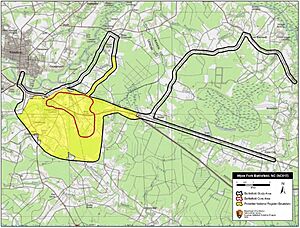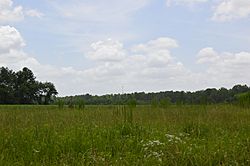Battle of Wyse Fork facts for kids
Quick facts for kids Battle of Wyse Fork |
|||||||
|---|---|---|---|---|---|---|---|
| Part of the Campaign of the Carolinas | |||||||
|
|||||||
| Belligerents | |||||||
| Commanders and leaders | |||||||
| John M. Schofield Jacob D. Cox |
Braxton Bragg | ||||||
| Units involved | |||||||
| Cox's Provisional Corps |
Department of North Carolina Hoke’s Division (Army of No. Virginia) |
||||||
| Strength | |||||||
| 12,000 | 8,500 | ||||||
| Casualties and losses | |||||||
| 1,257 | 1,500 | ||||||
The Battle of Wyse Fork, also known as the Battle of Kinston, was an important fight during the American Civil War. It happened in March 1865 in North Carolina. The Union Army won this battle. It was part of a bigger plan called the Campaign of the Carolinas, where Union forces were trying to link up and defeat the Confederate army.
Contents
Why the Battle Happened
This battle took place near the end of the Civil War. Union forces were pushing hard into the South.
Union's Plan to Join Forces
In February 1865, the city of Wilmington fell to Union troops. These troops were led by Major General John Schofield. Schofield's next job was to move his soldiers inland. He needed to meet up with Major General William Tecumseh Sherman's army at Goldsboro, North Carolina.
Once they met, three Union armies would join together. Their goal was to fight a Confederate army. This Confederate army was gathering under General Joseph E. Johnston.
Two Union Paths
Schofield sent some of his troops north from Wilmington. These were from Alfred Terry's Expeditionary Corps. Meanwhile, Major General Jacob Dolson Cox took his XXIII Corps division. They sailed up the coast and landed at New Bern, North Carolina.
At New Bern, more Union soldiers joined Cox. His forces grew to three divisions. They formed a special group called a Provisional Corps, with Cox in charge.
Confederate Response
As the Union forces moved toward Goldsboro, they fixed the railroad. This railroad was important. It would bring supplies to Sherman's large army. General Johnston's army was too far away to stop Schofield.
However, Confederate General Braxton Bragg's forces were closer. They were retreating from Wilmington. Bragg saw a chance to attack Cox's divided forces. So, Bragg moved his troops to fight Cox near Kinston.
Key Moments of the Battle
The fighting at Wyse Fork lasted for several days. It was a tough battle for both sides.
First Clashes on March 7
On March 7, Union advance units met Bragg's soldiers. The Confederates were dug in along Southwest Creek, east of Kinston. Bragg's position was strong. It blocked Cox's path and threatened a key crossroads. It also put the New Bern-Goldsboro Railroad at risk.
Cox understood how important this area was. He moved his divisions forward. Brigadier General Innis N. Palmer's troops protected the railroad. Major General Samuel P. Carter's troops guarded the roads.
Confederate Attacks
Bragg's forces also received help. Veterans from the Army of Tennessee joined them. Young soldiers from the North Carolina Junior Reserves also arrived. All these troops were under General Daniel Harvey Hill.
With more soldiers, Bragg decided to attack. He sent a division led by Robert Hoke to hit the Union's left side. Hoke's attack surprised a New England brigade in Carter's division. They even captured an entire regiment, the 15th Connecticut Volunteer Infantry.
Hill joined the attack with the Junior Reserves. But the young soldiers got scared and stopped. Hill left them and pushed on with his veterans. They hit the Union brigade and defeated it. The Union's left side was in danger.
However, Bragg stopped Hill's advance. He sent Hill far north to counter a Union threat. But when Hill got there, no Union soldiers were in sight.
Union Reinforcements Arrive
At this time, Cox returned to the front lines. He moved his reserve division forward. These troops, led by Major General Thomas H. Ruger, filled the gap between Palmer and Carter. This helped stabilize the Union line.
Fighting Continues
Small fights continued for the next few days. On March 10, Hoke tried again to get around the Union's left side. But the Union position was now very strong. They had many cannons. Hoke's attack was stopped within an hour.
Then, Hill attacked the Union center. Again, the Union cannons were too powerful. The attackers were pushed back. More Union troops from the XXIII Corps arrived in New Bern from Tennessee. They were moving toward Kinston. Facing five Union divisions, Bragg realized he could not win. He pulled his troops back.
What Happened Next
Bragg had only managed to slow down Cox's advance for a short time.
Union Armies Join Up
Schofield's forces grew to two full corps. They were organized into the Army of the Ohio. Meanwhile, Sherman's armies had just defeated Johnston's army at the Battle of Bentonville.
On March 23, Sherman's armies joined Schofield at Goldsboro. Now, three Union armies faced Johnston. Johnston had to retreat north. On April 26, General Johnston surrendered to General Sherman. This was a major step toward ending the Civil War.
Protecting the Battlefield
Efforts are being made to save parts of the Wyse Fork battlefield.
Preserved Land
The Civil War Trust (which is part of the American Battlefield Trust) and its partners have bought and saved 115 acres (0.47 km2) of the Wyse Fork battlefield. The battlefield is also listed on the National Register of Historic Places. This means it's recognized as an important historical site.
Current Threats
Today, the battlefield is in danger. A highway project by the North Carolina Department of Transportation (NCDOT) could destroy parts of it. This project is called STIP R2553 1SB. The highway interchange location is funded by North Carolina money, not federal funds.
You can visit the "Save Wyse Fork Battlefield from Destruction" Facebook page for more information.
Other Names for the Battle
This battle was also known by a few other names:
- Battle of Wyse's Fork
- Battle of Wise's Forks
- Battle of Wilcox's Bridge
- Battle of Kelly's Mill Pond
- Second Battle of Kinston
- Second Battle of Southwest Creek



